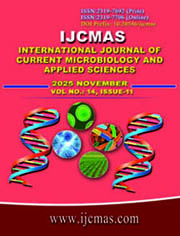


 National Academy of Agricultural Sciences (NAAS)
National Academy of Agricultural Sciences (NAAS)

|
PRINT ISSN : 2319-7692
Online ISSN : 2319-7706 Issues : 12 per year Publisher : Excellent Publishers Email : editorijcmas@gmail.com / submit@ijcmas.com Editor-in-chief: Dr.M.Prakash Index Copernicus ICV 2018: 95.39 NAAS RATING 2020: 5.38 |
Enteric fever is a life-threatening systemic illness caused by Salmonella Typhi and Salmonella paratyphi. It is transmitted by the fecal-oral route via contaminated food and water and is therefore common where sanitary conditions are inadequate and access to clean water is limited. Historically, the first-line agents (ampicillin, chloramphenicol, and trimethoprim-sulfamethoxazole) were the drug of choice for the management of enteric fever. Since the emergence of drug-resistant strains of Salmonella, first-line antibiotics fell out of favor and were not frequently used for this illness lately. Interestingly, there have been recent reports of first-line antibiotic susceptible Salmonella strains. This reemergence of first-line antibiotic sensitive Salmonella strains is promising and highlights the importance of continuous antibiogram surveillance and helps in typhoid management. To study the change in antibiogram pattern of Salmonella Typhi and Salmonella paratyphi a over two years. Samples such as blood, stool, urine, body fluids received in microbiology department of ASTER MIMS HOSPITAL are examined for salmonella using standard bacteriological methods. Antimicrobial susceptibility is tested using Kirby -Bauer disc diffusion method results interpreted according to CLSI guidelines. The VITEK® 2 Compact automatic system is employed for identification. Among the 133 isolates studied 66 identified as Salmonella Typhi and Salmonella Paratyphi A, people aged 21–30 were more in number. majority of isolates were from blood followed by bone marrow and stool, case numbers was peaking between April and July the overall antimicrobial susceptibility profile of Salmonella Typhi and S. Paratyphi A remained highly favorable for the firstline drugs that is ampicillin, amoxiclav, ceftriaxone and cefixime which continued to show 100 % sensitivity Although ciprofloxacinsusceptibility rate for S. Typhi was unchanged, resistance incresed by 6 %, and the proportion of intermediate isolates decreased by 7 %, In S. Paratyphi A, effectiveness of ciprofloxacin has declined by 17%, . Azithromycin Susceptibility has decreased in both isolates (1% for S. Typhi, 6 % for S. Paratyphi A). An increase in sensitivity to chloramphenicol was recorded (4% for S. Typhi, 14 % for S. Paratyphi A). Ampicillin, amoxiclav, ceftriaxone and cefxime continue to be the Most reliable empirical options, the gradual changes in ciprofoxacin and azithromycin susceptibility pattern highlights the importance of continual monitoring of change in antibiotic susceptibility to ensure effective treatment and address emerging resistance.
Admassu D, Egata G, Teklemariam Z. Prevalence and antimicrobial susceptibility pattern of Salmonella enterica serovar Typhi and Salmonella enterica serovar Paratyphi among febrile patients at Karamara Hospital, Jigjiga, eastern Ethiopia. SAGE Open Med. 2019 Mar 15; 7: 2050312119837854. https://doi.org/10.1177/2050312119837854.
Al-Tawfiq JA. Antimicrobial susceptibility of Salmonella typhi and non-typhi in a hospital in Eastern Saudi Arabia. J Chemother (Florence). 2007; 19 (1): 62-5. https://doi.org/10.1179/joc.2007.19.1.62.
Baig U mehdi SM a pattern of antibiotic drug resistance of Salmonella Typhi and Salmonella Paratyphi among childrens with enteric fever in a tertiary care hospital in Lahore, Pakistan. croat med J 2023 aug 31; 64 (4): 256-264. https://doi.org/10.3325/cmj 2023.64.256.
Biswas M, Biswas S, Gupta B, Mascellino MT, Rakshit A, Chakraborty B. Changing paradigms in antibiotic resistance in Salmonella species with focus on fluoroquinolone resistance: a 5- year retrospective study of enteric fever in a tertiary care hospital in Kolkata, India. Antibiotics (Basel). 2022 Sep 26; 11 (10):1308. https://doi.org/10.3390/antibiotics11101308.
Buckle GC, Walker CL, Black RE. Typhoid fever and paratyphoid fever: systematic review to estimate global morbidity and mortality for 2010. J Glob Health. 2012 Jun; 2 (1): 010401. https://doi.org/10.7189/jogh.02.010401.
Chandrashekar SC, Sudeep Kumar M. A study of antibiotic susceptibility pattern of Salmonella typhi and Salmonella Paratyphi A. Int J Curr Microbiol App Sci. 2018; 7 (2): 658-62.
Lakshmi V, Ashok R, Susmita J, Shailaja V. Changing trends in the antibiogram of Salmonella isolates at a tertiary care hospital in Hyderabad. Indian J Med Microbiol. 2006; 24 (1): 45-8. https://doi.org/10.4103/0255-0857.19894.
Parry CM. Epidemiological and clinical aspects of human typhoid fever. In: Wain J, editor. Salmonella infections: Clinical, immunological and molecular aspects. Cambridge: Cambridge University Press; 2006. p. 1–8.
Pérez Jorge G, Gontijo M, Silva MFE, Goes ICRDS, Jaimes-Florez YP, Coser LO, Rocha FJS, Giorgio S, Brocchi M. Attenuated mut ants of Salmonella enterica Typhimurium mediate melanoma regression via an immune response. Exp Biol Med (Maywood). 2024 Jun 21; 249: 10081. https://doi.org/10.3389/ebm.2024.10081.
Rashed, M. R., Yadav, A., & Jakribettu, R. P. (2019). Trends in antimicrobial susceptibility of blood culture-positive typhoid fever over half a decade in adults attending a tertiary care teaching hospital in South India. International Journal of Basic & Clinical Pharmacology, 8 (11), 2523–2527
Sajib MSI, Tanmoy AM, Hooda Y, Rahman H, Andrews JR, Garrett DO, Endtz HP, Saha SK, Saha S. Tracking the emergence of azithromycin resistance in multiple genotypes of typhoidal Salmonella. mBio. 2021 Feb 16; 12 (1): e03481-20. https://doi.org/10.1128/mBio.03481-20.
Sathish kumar reddy G, N Raghu Prakash Reddy.antimicrobial susceptibility pattern for salmonella typhi in a tertiary care hospital. International journal of pharmaceutical and clinical research 2023; 15 (7); 1340-1342
Sjölund-Karlsson M, Joyce K, Blickenstaff K, Ball T, Haro J, Medalla FM, Fedorka-Cray P, Zhao S, Crump JA, Whichard JM. Antimicrobial susceptibility to azithromycin among Salmonella enterica isolates from the United States. Antimicrob Agents Chemother. 2011 Sep; 55 (9): 3985-9. https://doi.org/10.1128/AAC.00590-11.
Umair M, Siddiqui SA. Antibiotic susceptibility patterns of Salmonella Typhi and Salmonella Paratyphi in a tertiary care hospital in Islamabad. Cureus. 2020 Sep 3; 12 (9): e10228. https://doi.org/10.7759/cureus.10228.
 |
 |
 |
 |
 |